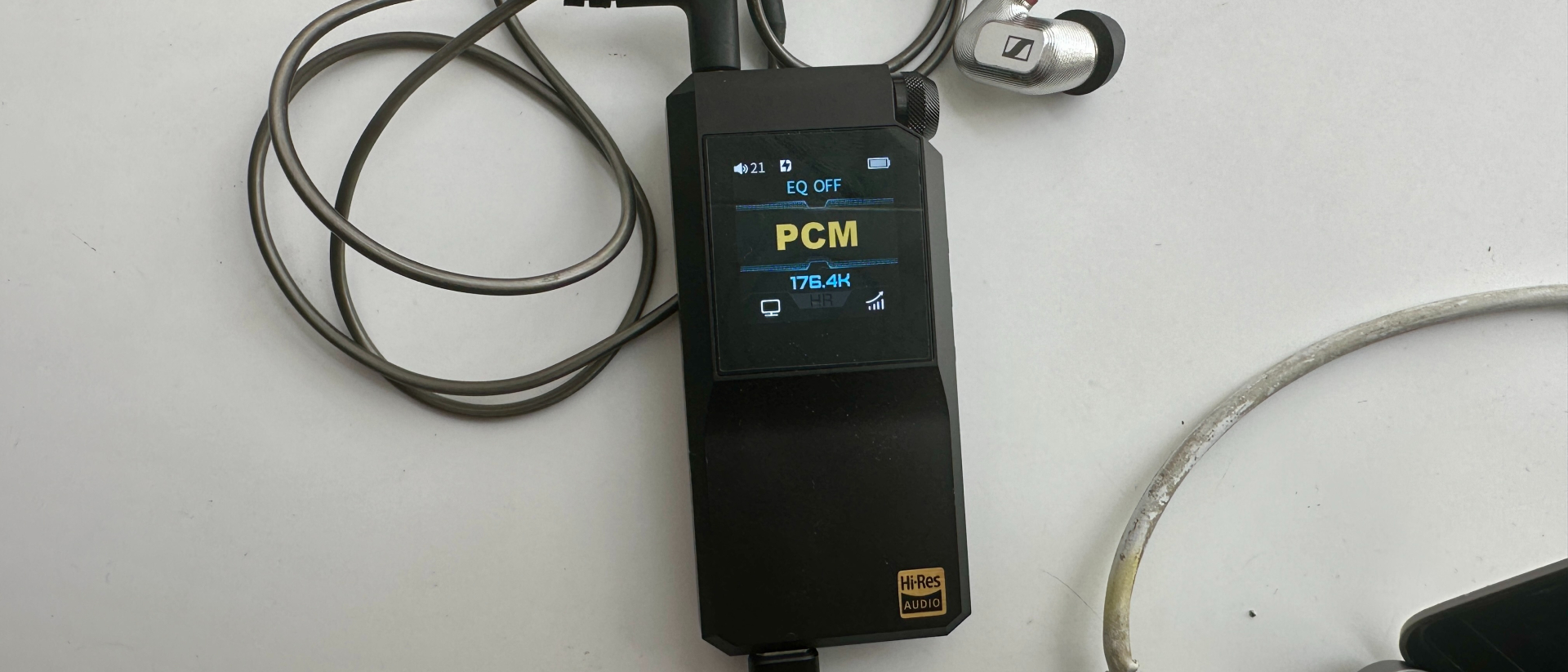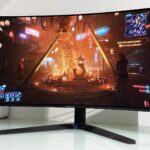Why you can trust TechRadar
We spend hours testing every product or service we review, so you can be sure you’re buying the best. Find out more about how we test.
FiiO BTR17 review: Two-minute review
Another day, another intriguing FiiO product. Today it’s the BTR17 portable Bluetooth DAC/headphone amplifier, and it seems safe to say it represents another day of FiiO business as usual.
The BTR17 is small, but it’s packed with functionality and specified in a way that seems beyond the tiny physical confines of the device itself. Between Bluetooth 5.4 with top-of-the-shop codec compatibility, a pair of ESS ES9069Q DACs, an disproportionate amount of power when used as a desktop headphone amp, decent battery life, the ability to deal with enormously high-resolution digital audio files, and a choice of balanced or unbalanced headphone outputs, it’s obvious FiiO has endeavoured to do the right thing here.
And that impression of ‘good intentions’ becomes even stronger when you hear the BTR17 in action. There are qualitative differences, of course, between using the FiiO as a wireless receiver and using it as a dongle hard-wired to a smartphone or laptop – but what doesn’t alter no matter the circumstances are the broad strokes of its sonic character.
And generally, it’s a character that’s fast, insightful, properly controlled and very satisfying to listen to. Or, at least, it is if you’re not expecting comparable bass power to the bass speed that’s on display here – the FiiO BTR17 is a rapid, direct listen, but it’s far from the chunkiest sound around. Investigating your options in the menus can bring about some changes in character, but they’re exclusively to the detriment of the device’s fundamental character and attitude.
Come on then, is it still one of the best portable DACs available for this money? Yes, with one caveat (which I’ll come to).
If the balance is not to your taste, you’ll look elsewhere/. But those who value speed and dexterity of sound as much as (if not more than) straightforward ‘wallop’ will enjoy the BTR17 no end.
FiiO BTR17 review: Price and release date
- Launched in early November 2024
- Priced $219 / £179 / AU$349
The FiiO BTR17 portable Bluetooth DAC/headphone amplifier is on sale now, and in the United Kingdom it sells for no more than £179. In the United States it’s currently $219* and in Australia you’re looking at AU$329. So no matter the territory you’re shopping in, the BTR17 seems notable value for money.
If you don’t mind wired connections of course, the world isn’t exactly hunting high and low for an affordable USB DAC (see the pricier $499 / £449 / AU$769, the iFi GO Bar Kensei, the iFi Go Link Max at just $79 / £79 / AU$139 the five-star iFi hip-dac 3 at $199 / £199 / AU$349 for starters). But nevertheless, the combination of price and wireless specification could win out here…
(*subject to tariff-related change on a seemingly daily basis.)
FiiO BTR17 review: Features
- 32bit/768kHz and DSD512 support
- Bluetooth 5.4 with LDAC and aptX Lossless compatibility
- 650mW + 650mW balanced power for headphone amplification
It shouldn’t really come as any kind of surprise at this point that FiiO has specified one of its products in a manner that might easily shame an equivalent product from an alternative brand. And yet I find I’m still mildly startled but just how far into town FiiO has gone with the BTR17.
Regardless of the way the digital audio information gets on board, either by USB-C or via Bluetooth, it’s dealt with by a pair of ESS ES9069Q DACs that are able to handle every major file type up to 32bit/768kHz and DSD512 resolution. If you decide to go with Bluetooth, you have the luxury of the 5.4 version with codec compatibility all the way to LDAC and aptX Lossless – the use of a Qualcomm QCC5181 Bluetooth chip to do the necessary means the FiiO is LE Audio-compliant, too.
Use the BTR17 in ‘desktop’ mode with its ‘power in’ USB slot connected to a source of USB power (FiiO provides a little length of monocrystalline silver- and copper-plated eight-strand USB-C / USB-C cable to ensure clean power and accurate data transfer)and it can churn out a substantial 650mW + 650mW of balanced power. This is the sort of output more commonly associated with bigger desktop headphone amps, and is ample to drive even quite truculent headphones.
If you’re using battery power rather than USB-C power, the BTR17 will run for anywhere between seven hours (making a Bluetooth connection, using a power-hungry codec, driving balanced headphones via the 4.4mm output and listening at hefty volume) and ten hours (in ‘phone’ mode, at modest volume, driving headphones via the unbalanced 3.5mm output and listening to stuff of no more than 16bit/44.1kHz resolution). Charging from ‘flat’ to ‘full’ is a 90-minute job.
Unsurprisingly, there’s more – just as there was with the older FiiO BTR7 Bluetooth DAC (which is not to be confused with the newer model you’re reading about today). The BTR17 has a three-stage, ten-rail power supply, and it has multi-stage architecture of the type FiiO fits to its pricey digital audio players. It has a ‘driver-free’ mode that means it can connect to a PS5, a Switch or something like that directly, without the need for downloaded drivers. It has integrated DC output and temperature detection to protect the device if conditions take a turn for the abnormal. And I could go on – but let’s just wrap this section up by saying FiiO has laid in on, specification-wise, with a trowel here.
Features score: 5 / 5
FiiO BTR17 review: Sound quality
- Great sonic momentum and rhythmic positivity
- Detailed and insightful
- ‘All or nothing’ EQ and filter adjustments
I’ve heard a few DAC/headphone amp devices lately that have sounded muscle-bound and barrel-chested in the manner of a bulldog. The FiiO BTR17, by way of happy contrast, is more of a greyhound.
There’s a rapidity, a kind of entirely naturalistic momentum, to the FiiO’s sound no matter if it’s receiving its digital audio information wirelessly via Bluetooth or through one of its USB-C sockets. A fleet-footed recording like Broadcast’s Black Cat fairly motors along – the BTR17 expresses the rhythm with complete conviction, and the tune stays on the front foot as result. There’s nothing forced about the way it’s presented, though – it doesn’t hang around, but neither does it feel like it’s being prodded forwards.
Part of this impression comes from the way the BTR17 handles the leading edge of low-frequency sounds – there’s no overhang or slurring, instead the FiiO snaps into bass information with real purpose. There are some minor issues at the bottom of the frequency range, and I’ll get to those – but there’s no arguing with the speed this little device can invest a recording with.
This is not at the expense of organisation, either. The FiiO creates a decently spacious and easy-to-understand soundstage, and can spread out even complex recordings to the point that individual elements are easy to highlight. There’s plenty of detail available at every part of the frequency range, and the BTR17 is just as attentive to fleeting and/or very minor occurrences as it is to the broader strokes. The upshot is a presentation that seems very much like it’s the complete picture.
Overall tonality is, in almost every circumstance, quite carefully neutral and uncolored, so if you play a warm and sepia-coloured recording like Johnny Too Bad by The Slickers, or a blue-ish and low-temperature number like Floating World by Zodiac Free Arts Club, what goes in is what comes out. The BTR17, left to its own devices, seems perfectly happy not to stick its oar in.
Integration of the frequency range is good, too, with no area being overplayed. I’ve heard plenty of products like this that will ramp up the bottom end or shove the midrange forwards, but that’s the FiiO’s scene at all.
There’s not an awful lot of meat on the low-frequency bones here, though. The BTR17 can dig fairly deep and hit reasonably hard, but low-end substance is in fairly short supply. Of course, a positive knock-on of this trait is that speed and manoeuvrability I’ve already discussed – but there’s also a downside which anyone who’s interested in bass for the sake of bass will already have worked out for themselves.
There are options in the device’s menus to finesse the EQ settings, of course, and also to investigate various filters – you might think this slightly flyweight presentation could be mitigated somewhat this way. But the effects of each are mild in the extreme, right until the moment they become rather ham-fisted and end up spoiling the carefully shaped low-frequency response. You can make the BTR17 sound weightier than it really wants to if you set your mind to it – but you’ll be affecting its speed and rhythmic positivity at the same time. And not in a good way.
Sound quality: 4 / 5
FiiO BTR17 review: Design
- 87 x 41 x 16mm (HxWxD)
- Black or blue finishes
- 73g
When a product is sincerely intended to be ‘portable’, design has to take a back seat to ‘getting everything into a package as small and light as is realistically possible’. So apart from the little ledge beneath the 33mm screen on the front of the BTR17 and the mildly interesting ‘turn/push’ control at the top left, its 87 x 41 x 16mm (HxWxD), 73g chassis is entirely unremarkable. And that’s the case regardless of which of the black or blue finishes you choose.
There’s absolutely nothing wrong with the build quality here, though, nor the standard of finish. The BTR17 is almost entirely plastic, but it’s reasonably tactile and seems made to last.
Design score: 5 / 5
FiiO BTR17 review: Usability and setup
- Tiny physical controls
- Full-colour screen
- Staggeringly in-depth control app
The BTR17’s 33mm display may look unhelpfully small, but it’s a crisp, full-colour IPS job and manages to legibly confirm file type or Bluetooth codec, sample rate, EQ setting, battery life and volume level all at the same time. It also gives access to menus that allow adjustment to gain gradients, audio filters, a choice of EQ presets, screen brightness and so on.
You navigate the menus using the rotary control on the top left edge of the BTR17. It feels and looks good, and operates with pleasant positivity – and it also gives access to volume control, ‘play/pause’ and telephony functions. There are other controls arranged beneath it down the edge of the machine – they are, inevitably, very small, and their labelling is even smaller. But take the time to commit their functions to memory and you can deal with ‘skip forwards/backwards’, ‘power on/off’, select ‘Bluetooth’, ‘phone’ or ‘PC’ your usage mode, and switch ‘desktop’ mode on or off.
Those usage modes have a big part to play in the BTR17’s battery life. In ‘PC’ mode, it’s powered by the computer it’s connected to. In ‘phone’ mode, its internal battery contributes to power supply, which reduces the load on your smartphone. In ‘BT’ mode, all the power is coming from the FiiO’s internal battery.
Physical connection to a computer or a smartphone is via one of the two USB-C slots on the bottom of the BTR17. Either can be used for charging and for data transfer, and one is also for power input when the device is in ‘desktop’ mode. At the opposite end of the device, meanwhile, there are Back in the mainstream world, there are a couple of headphone outputs – one is an unbalanced 3.5mm socket, the other a 4.4mm balanced equivalent.
There’s a huge, almost unnecessarily extensive, amount of functionality available in the ‘FiiO Control’ app. Want to adjust the ‘double-click’ function of those physical ‘skip forwards/backwards’ buttons, or create a custom EQ using a ten-band equaliser, or switch ‘distortion compensation’ in a couple of harmonic ranges on or off, or adjust the channel balance between ‘left’ and ‘right’? This is where you do it. If you want a slider to control the length of time the BTR17’s screen stays on, or how bright it is, or how long it stays switched on while it’s at rest, you can do it here too. Unless you’re the sort of person who can’t rest until they’ve customised the minutiae of their audio equipment’s set-up and performance, it is likely to seem like overkill.
Usability and setup score: 4 / 5
FiiO BTR17 review: Value
- You can’t pick fault with the value for money
- Performs its duties admirably
Obviously it’s important to judge ‘value’ on a basis other than that of ‘how much stuff do I get?” – because while the FiiO BTR17 is necessarily small and light, it’s got a lot of functionality and it performs really well.
Most USB DAC/headphone amps at this sort of money don’t have a wireless aspect to their performance. Very few have a display or a control app, and fewer still have the sort of alacrity of sound the BTR17 can summon. Its sonic attitude will not be for everyone, but for those who are partial, there is excellent value for money to be had here.
Value score: 5 / 5
Should I buy the FiiO BTR17?
|
Attributes |
Notes |
Rating |
|---|---|---|
|
Features |
Even allowing for FiiO being FiiO, this thing is comprehensively specified |
5/5 |
|
Design |
It’s super small and still has a useful screen |
5/5 |
|
Sound quality |
Detailed, agile, neutral – just could be a tiny bit punchier |
4/5 |
|
Value |
It would be an error to argue with the sound-per-pound value here |
5/5 |
Buy it if…
Don’t buy it if…
FiiO BTR17 review: Also consider
The iFi Go Link Max is a great-sounding USB-C DAC/headphone amp that’s compact and well-made – but it doesn’t have Bluetooth connectivity.
Helm Audio’s Bolt USB-C DAC/headphone amp is another great performer and no hardship at all to listen to – but, again, there’s no wireless functionality here.
How I tested the FiiO BTR17
- Used while working, while commuting and in the car
- Listened in wireless Bluetooth mode, and using wired options
I used the BTR17 as a desktop DAC/headphone amp, connected to my Apple MacBook Pro. I used it connected to an Apple iPhone 14 via its USB-C socket, too, which allowed me to use wired headphones with a device with no headphone socket – and I also connected it wirelessly via Bluetooth to the smartphone, just for the sake of completeness.
I also found it a useful device when in a car with no wireless connectivity – Bluetooth from my smartphone to the FiiO, and the out of the BTR17’s 3.5mm unbalanced headphone socket to the ‘aux’ input of the in-car audio system. In every circumstance, no matter the type of connection or the type of music playing, the little FiiO was always a speedy and revealing listen.
Read the full article here













